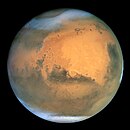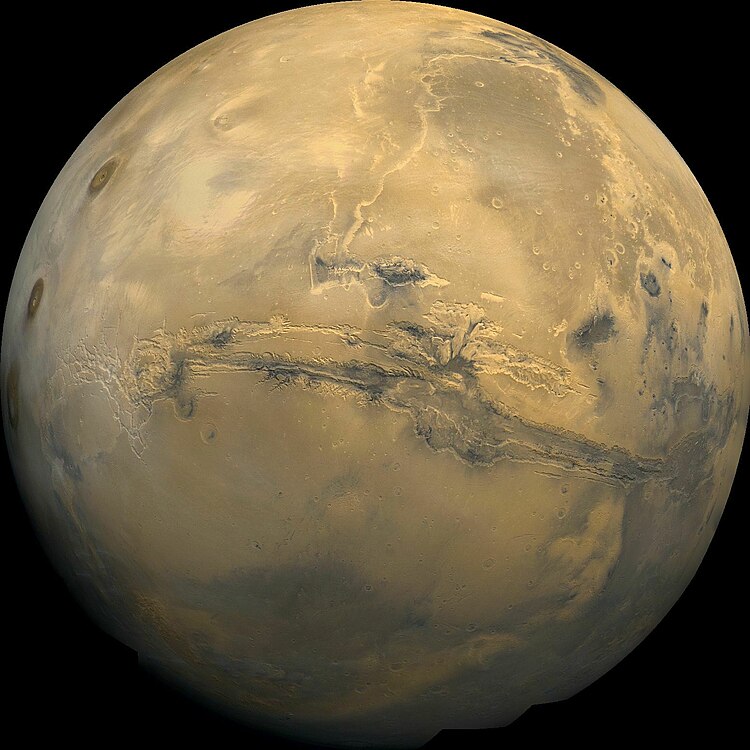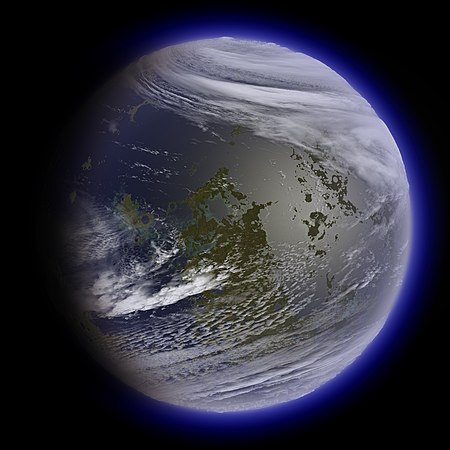Colonizing Outer Space/Colonization/Space/Generalities/Celestial Bodies
Colonizing Mars
[edit | edit source]

Mars is a frequent topic of discussion regarding colonization possibilities. A project for the colonization of Mars provides an opportunity to examine how we live here on Earth and what aspects of our own planet and its effects on our lives we value and would wish to re-create on Mars. The Mars Project also provides a case-study for further planetary colonization.
Mars overall surface area is similar to the dry land surface Earth, it has large water reserves, and has carbon (locked as carbon dioxide in the atmosphere). It may have gone through similar geological and hydrological processes as Earth and contain valuable mineral ores, but this is debated.
Mars's atmosphere is very thin (averaging 800 Pa or about 0.8% of Earth sea-level atmospheric pressure) and the climate is colder. Its gravity is only around a third that of Earth. Mars is often the topic of discussion regarding terraforming to make the entire planet or at least large portions of it habitable.
As of 2011, according to the Journal of Cosmology, an interplanetary trip to Mars from Earth, could take as little as 10 months, and it would be possible for a privately-funded one-way mission to Mars to depart as soon as 20 years from now. But returning would be virtually impossible (due to payload and energy restrictions).
In regards to volunteers, in 2011 a special edition of the Journal of Cosmology, detailing and promoting a privately-funded one-way mission to Mars prompted more than 400 readers to volunteer as colonists. This leads to the conclusion that there are people willing to take on the risk, but it also creates the need to select those that should and are more capable of being successful.
Solar energy would be a problem in mars, there is not only night time to consider but a large amount of dust.


There is an ongoing debate on this topic on the Mars Civil-Cultural mailing list. One way that this topic can be explored is to look at the lessons learned from science fiction.
Life and fossils
[edit | edit source]There is increasing evidences that point to the, at least ancient, presence of life on Mars, this has created a strong scientific interest in colonizing Mars. A study from 2011 from NASA indicates that if life existed on at some point in Mars history, the best chances for it to have survived (or at least to have persisted longer) would have been below the surface. This hypothesis is based in geological studies performed by probes from NASA and the European Space Agency in more than 350 sites, along with what is known of mars today.
Water
[edit | edit source]Water is one of the most important substances for life as we know it. In the last three decades upon reviewing images of the surface of Mars taken by the Viking orbiters in the 70s, scientists became puzzled by the apparent sloping of rocky material around mountains and cliffs, these deposits, referred to as lobate debris apron, seems to extend sometimes for tens of miles. The debate around those formations generated the theory that they may have been formed by the lubrication of the rocky debris by a thin layer of ice, since similar features can be observed on Earth, for instance in Antarctica.
A new indication that water seems to exist on the planet came from data collected by the Shallow Subsurface Radar (SHARAD) instrument aboard the Mars Reconnaissance Orbiter probe, lunched in August 12, 2005 and operating at destination from 2006 onward. The radar results are consistent with massive deposits of water in middle latitudes, providing further support for the debris covered glacier hypothesis.
Equipment is available to extract in situ resources (water, air, etc.) from the Martian ground and atmosphere.
Agriculture
[edit | edit source]Martian soil contains several nutrients required to support to plant life. With fertilizer and environmental control, it could be used to grow plants.
Artifacts and equipment already available
[edit | edit source]There are several artifacts left on the surface of Mars from previous exploration and still working equipment, like monitoring satellites.
Colonies on the Moon
[edit | edit source]
The Moon is Earth's only natural satellite, it is also known as Luna in Latin and other languages. Due to its proximity and relative familiarity, Earth's Moon is also frequently discussed as a target for colonization.
A colony on Luna has several important advantages over a colony on any other celestial body outside Earth. One big advantage is that it is close proximity to Earth. It would be comparatively easy to supply any colonization process, place and evacuate colonists, and use radio signals for reprogramming and remote control of robots and other devices on the Moon's surface. Another advantage is the low gravity, allowing for easier exchange of goods and services. But the topmost advantage is that we already have been there.

Solar energy on the moon is a possibility by the moon has two week nights and similar to Mars dust will constitute a problem, not atmospheric dust but the surface regolith is an extreme problem, making nuclear power more attractive.
A major drawback of the Moon is its low abundance of volatiles necessary for life such as hydrogen and carbon. Water ice deposits was found in relative abundance, especially in some polar craters, that could serve as significant sources for these elements.
India's first unmanned lunar probe, launched in 22 October 2008, Chandrayaan-1 intended to last for 2 years in a compressive mapping of moon resources has generated data that leads NASA's scientists to estimate the existence of 600 million metric tons of water ice in craters around the Moon's north pole.
The existence of numerous craters near the poles of the Moon that have interiors that are in permanent sun shadow, makes them capable of maintaining very low temperatures. Without the effects from the Sun's radiation water can be indefinitely kept as ice. If this estimation is verified, mining this resource, could serve as a source of life support for future lunar bases as water and oxygen or as propellant for future spacecraft if converted to methane, dramatically reducing the cost of space exploration. NASA in April 2012 contracted Astrobotic Technology Inc. to determine whether its polar rover can deploy an ice-prospecting payload to the Moon, aiming for such verification.
There are also several magma caves that would facilitate the creation of protected habitats.








According to M.J. Fogg, "it is just possible to terraform the Earth's moon, so long as you are prepared to keep its imported volatiles topped up every few thousand years or so".</ref> http://www.users.globalnet.co.uk/~mfogg/gallery.htm </ref>
- The lunar space elevator


Planed Moon Colonies
[edit | edit source]China
Mercury
[edit | edit source]There is a suggestion that Mercury could be colonized using the same technology, approach and equipment that is used in colonization of the Moon.
Venus
[edit | edit source]While the surface of Venus is far too hot and features atmospheric pressure at least 90 times that at sea level on Earth, its massive atmosphere offers an alternate location for colonization. At a height of approximately 50 km, the pressure is reduced to a few atmospheres, and the temperature would be between 40-100° C, depending on the height. This part of the atmosphere is probably within dense clouds which contain some sulphuric acid. Even these have a certain benefit to colonization, as they present a possible source for the extraction of water. Thus, the most likely colony on Venus would be a floating city in the clouds that stays above 50 km above the surface.
Europa
[edit | edit source]The Artemis Project designed a plan to colonize Europa, one of Jupiter's moons. Scientists were to inhabit igloos and drill down into the Europan ice crust, exploring any sub-surface ocean. It also discusses use of "air pockets" for human inhabitation.
Gas Giants
[edit | edit source]It may also be possible to colonize the three furthest gas giants with floating cities in their atmospheres. By heating hydrogen balloons large masses can be suspended underneath at roughly Earth gravity. Jupiter would be unsuitable for habitation due to its high gravity, escape velocity and radiation. Such colonies could export Helium-3 which would be used to fuel fusion reactors for energy.

